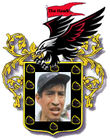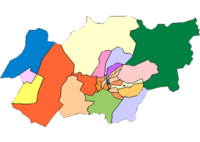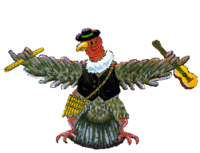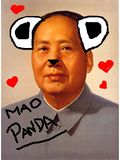Arequipa, Peru
| |||||
No, it's not Kazakhstan, is Arequipa | |||||
| Capital | Arequipa (arequipeans aren't very creative) | ||||
| Motto | Limeños talk funny | ||||
| Anthem | We are part of Peru... NOT! | ||||
| Largest city | Arequipa | ||||
| Official languages | Arequipeño (a Scouse sort of Spanish) | ||||
| Emperor | Elmer I of Arequipa | ||||
| Currency | Golden Characato | ||||
| Religion | Adoration of the sun | ||||
| Population | 749,921, the rest are cholos | ||||
| Population density | Humans: Pretty dense; Guano: Rock-solid | ||||
“In my veins does not flow blood, but boiling lava.”
– Crazy guy on circulatory system.
The Holy Inca-Arequipean Empire is, as its name suggests, a holy inca-arequipean empire, which means it's just a city in southern Peru. Its nickname is "the White City", an assertion that can mean only two things: Gringos and guano, since both have accumulated on the main plaza and most of the churches. It's the second most populated country in Peru, right after Peru. Arequipa is also a state (departamento) of Peru, which contains not only the namesake city and the volcanoes but comparatively useful ocean frontage.
Etymology[edit | edit source]
Tradition has it that the name (i.e. Arequipa, pay attention) comes from an ancient Inca emperor whom his men decided to abandon in the Chili Valley. They asked him for permission because even in leaving they had respect for the emperor, to which he, who had also had enough of them, replied "Ari, quepay", which means "Yes, stay, but then don't come to bother me when you can't pay the rent".
There are other theories, but nobody cares about them.
Nickname[edit | edit source]
As we already said, Arequipa City nickname is "The White City". The reason behind it is still a mystery, but because we are such good people we're going to present some of the most widespread theories to explain it.
- According to Wikipedia, the name comes from the ashlar with which the city is built, which if you look at it from afar looks white (and it is better to look at the city from afar).
- According to some guy, the name comes from the huge number of Spaniards who came to the city in the viceroyalty to be cured of smallpox (and in passing, spread it to the rest).
- Other theories suggest that the nickname is more recent and was given by Adolf Hitler, who liked the city and wanted to establish a new Nazi regime there. This theory was discarded because everyone knows that Hitler is living his retirement in Argentina.
In conclusion: nobody knows, so if they ask you, say it was a magician and run away.
Definitions[edit | edit source]
This article uses the following local terms so that its shameless stereotypes seem really authentic:
- ñ is the letter enye, also known as "La Mustachía". You read limeño, you say lee-MAY-nyo. You read puneño, you say "Ew!!!"
- Arequipeño is the term for the proud, self-centered, closed-minded, conceited, overendowed, lily-white residents of Arequipa. They live in tiny neighborhoods, have DirecTV, study at private high schools and universities, have a beach house in Camaná, and have security guards for their daughters to keep them from falling for a Puneño, as a dark-skinned baby would ruin the royal family painting.
- Limeño is the term for the worst enemies of Arequipeños, the capitalinos who live in Lima. They are ignorant, totally gay (outside of Lima, that's not always a badge of honor), coqueros, and conceited. The ignorance and poor educaton of Limeños causes them to mispronounce words such as pessscado, saying something like pejjjcado.
- Puneño is a synonym for cholo. Cholo roughly translates to "darkie" but can conveniently be applied to residents of Puno, whatever their color. Puno is a city. Puño is a fist. Puneños have nothing to do with fists, provided they stay the hell out of Arequipa.
You are seeing that Spanish, not unlike the condor of Arequipa, is very regular. So here is an exception:
- Mamacha is the term for any random fat old chola. Many invading puneños are mamachas who have been attracted by the animal magnetism of the Arequipeño. A mamacha has many uses, like selling pirate shirts on the street, something very appreciated by everyone when there is no money for a real one. It is perhaps the only subspecies of puneño that has any use.
In summary, Arequipeños have derogatory terms for the people on all sides of them. This happens nowhere else in Peru.
Historical overview[edit | edit source]
In the beginning, Arequipa was occupied only by nomadic Indians who were exclusively devoted to hunting all guano birds (to eat the guano), leaving the territory free of guano, which would move to Ica.
Later, much later, the territory was occupied by the Inca Empire, who used it to exile people, until they realized that the best place for exile was Puno, where they built the first GULAGs in history. But that has nothing to do with Arequipa, so there is no point in mentioning it. Back to the important subject (important?), at the arrival of the Spaniards, Arequipa was also occupied, being founded by some very lost Spaniards who thought they were in Los Angeles, led by Garcí Manuel de Carbajal, a drunkard by profession.
In the viceregal period of Peru in general, Arequipa stood out for only one thing: being loved by all the Spaniards, it is still not known why (it is believed to have been caused by the huge Spaniard-attractor magical magnet). The Spaniards liked it so much that it made Charles V himself so fanatical about it that he promoted it from a suburban village to a metropolis in some year (I don't remember cause it doesn't matter).
It was governed in the same way as all the other cities of the viceroyalty of Peru (that is, there was the Inquisition, indigenous exploitation, and smallpox, especially smallpox), until what had to happen happened: the protagonists fuck independence arrived to the entire continent. In Arequipa the process was different, for while Simón Bolívar and his friends liberated countries by force, Spain gave up its freedom to Arequipa willingly, as proof that they still loved them very much. Thus Arequipa began its period as a Spanish enclave independent empire.
According to the Oxford dictionary, an empire is "a political entity that exercises power over other peoples". Thus, roughly speaking, Arequipa was an empire, since it still maintained control from the shadows of Peru, and also had its own territory. Its imperial period, to tell the truth, did not last long, since they were given their independence in 1820 and two days later, in 1821, it was incorporated into the newly created Peru. While it lasted, the Holy Inca-Arequipa Empire had the same extension that Arequipa has today, but it exercised dominion over the city of Lima and Puno. As it does today.
Since then, nothing worth mentioning has happened in Arequipa, except for that time they rebelled against Peru and almost killed the president, or that other time they rebelled against Peru and almost killed the president.
Culture[edit | edit source]
Army[edit | edit source]
The army of Arequipa is called "People's Ninja Sacred Army" (PENIS, do not count the a in "Army" because it would be redundant if it's an army and is called army). It's comprised in two main branches:
- The divisions 1, 2 and 4 infantry (the 3 does not exist because of the bad luck of the number) are the divisions of the army in charge of protecting the borders and, in case it is possible, to lead an invasion to Iran. It is made up of a group of arequipean volunteers, mostly farmers or mafia soldiers. Its more than 100,000,000 troops exceed the number of inhabitants of the city or even of Peru, so it is suspected that the figures are somewhat exaggerated. Their only weakness is fire, guns, bullets, bulls, and anything white-red in color.
- The Royal Guard of Misti Volcano is a select group chosen from among the most honorable members of the city, such as thieves, assassins and priests. They are led by the Mummy Juanita herself, who after being resurrected as a zombie took the reins of the Order.
National symbols[edit | edit source]
The flag of Arequipa owes its unique design to crysthal meth. The background, of a full maroon iridescent color that once every 110 years is changed to neon green, is adorned in front by the coat of arms of the city, formed by a very strange composition that includes lions, volcanoes, Charles V and poppies at the edges.
The anthem of Arequipa did not exist until relatively recently, in fact, it still does not exist being created for the 1200th anniversary of the city. In its chorus one can appreciate the peculiar Arequipa lifestyle, with the verse "To the white, to the white, to thw white and heroic city" (a reference to cocaine).
The people[edit | edit source]
The only thing Arequipeños love more than spicy food, and of course themselves, is arguing into the night with anyone over anything.
Arequipeños delicately balance strengths and weaknesses, a bit less delicately when anyone points out the latter, which include arrogance, the inability to get along with others or even listen a little bit, and carnal attraction to barnyard animals.
Their strengths are that their evening arguments are often loud enough to scare away rats and other vermin that might spread disease.
- Famous Arequipeños
General Vizcachú is the ancient Mayan military leader who set up the bivouac that became the city of Arequipa. It was his troops who named the region ari qhipaya, from Aymara ari (acute, sharp, or pointed) and qhipaya (behind), as he was a smart-ass. While in the region, he whipped his troops into a frenzy with heroic tales of battle—until word came through that the combat was occurring down at sea level and everyone would have to go back down to be any use at all.
Panda Mao was the ideological force behind the indigent terrorist sect, the Sendero Mierdoso. He led a raid to bomb strategic private residences in Lima but was routed by the betrayal of his second-in-command, a funny guy named Fuji with aspirations of a political career.
The ideological force behind the currently active terrorist sect is a fellow by the name of García.
The prize for Arequipan Man of the Year went to Héctor Lucas Núñez y Núñez de Núñez, an engineer in downtown Arequipa. Using software unique to the city called MS-DOS, he was the first to figure out how to busy himself on two screens running independently, a process that Arequipeños refer to as "multiprocessing". Arequipa prides itself on being the informatics capital of Peru, apart from advances reportedly made in Lima, of which Arequipeños are skeptical.
Interesting places to visit[edit | edit source]
The state of Arequipa is full of variety, from shitty volcanos all the way to shitty beaches.
Mount Misti[edit | edit source]
Mount Misti is at the very heart of Arequipa. It is an active volcano that could blow any day now. The most notable thing about Mount Misti is that Arequipeños couldn't care less if it pops, from the campesinos shoveling hay to their livestock to the city-dwellers a bit further down-lava-stream from it. We were all taught to admire the Roman centurion who stood his post until buried by the spew of Mt. Etna, but that was attention to duty, whereas in the case of Arequipeños it will be sheer apathy.
Mount Misti is patrolled by the Eye that Never Sleeps, which resides at the top of the nearby broadcast tower. Occasionally, tourists have visited Arequipa to climb Mount Misti and throw a Ring of Power into the chasm. To this date, all have abandoned this heroic quest, quailing of their mission, in the face of the knowledge that it would then fall on their shoulders to feed and clothe two million beggars.
Cañon del Colca[edit | edit source]
“Oshy, mira, Gringo! Ay 'ta il condor!”
– "Hey, whitey! There's a condor!" The last thing many tourists hear before being pushed over the edge
Remember, you see Cañon, you say "canyon." This natural depression is the lowest point in Arequipa, and perfectly offsets the many man-made depressions in the region. Colca attracts millions of tourists who hope to see a condor. Unfortunately, many of them find it is a far better place to see a mugger.
Mejía[edit | edit source]
Mejía is the famous beach on the Arequipa coast. Geographically and culturally, it is as close as any Arequipeño comes to Eisha. Arequipeño counter-spies holiday here, although those who approach the shore are often drowned by a lifeguard suspiciously wearing a full-body black swimsuit instead of the regulation orange.
The sea is home to three varieties of fish:
- A variety called pescado
- A variety called pejcado
- A variety called "q xuxa es eso?"--especially in texting.
Arequipeños prize the pure-white sands of Mejía, perhaps a bit less once they discover what guano really is.
A word about Puno[edit | edit source]
Perhaps Puno deserves mention. This city of 100,000 was founded under the name Saint John the Baptist of Puno. Then it occurred that the idea of baptizing a Puneño was too rich to say with a straight face, as indeed is the idea of a Puneño coming close to the amount of drinking water in most baptismal fonts.
However, Puneños do swim in the adjacent Lake Titicaca, so many of them at the same time that they are often referred to as the "floating islands" of Puno, somewhat like Indians' group immersion in the River Ganges, but without the spiritual purification.
Puno is a way-station for indigenous peoples who descend from the sierra, or fall out of coconut trees in the selva, and migrate in search of economic prosperity. This journey will eventually take them through Arequipa and Lima and ultimately to a hospital emergency room in the United States.
Puno is a key bulwark in the southern defense of Peru, especially as the gigantic Arica base of the Peruvian Air Force (unfortunately known by its Spanish acronym, FAP) is now formally a part of Chile.











